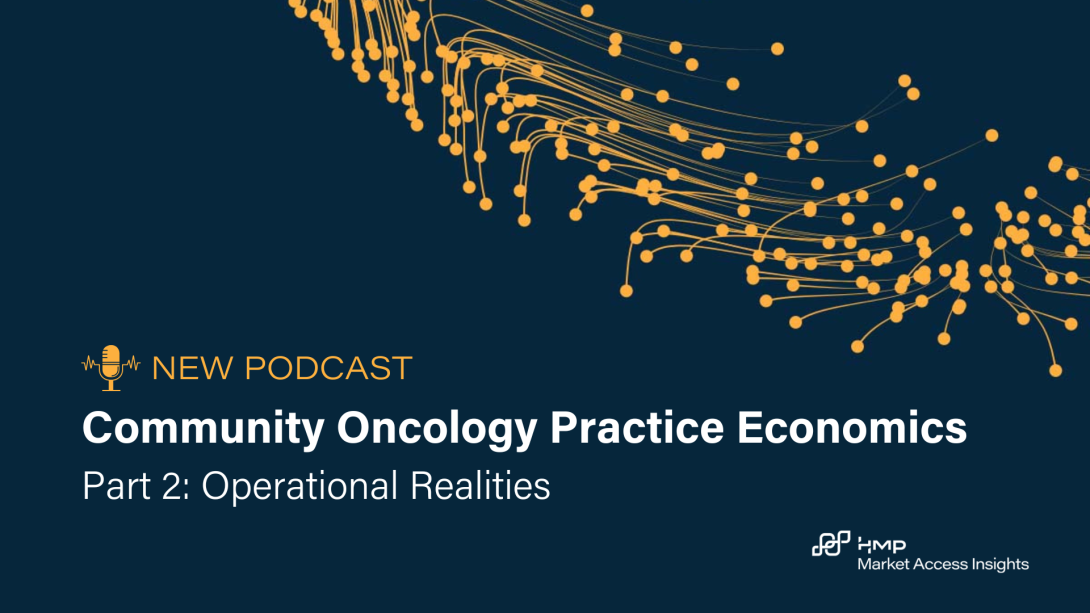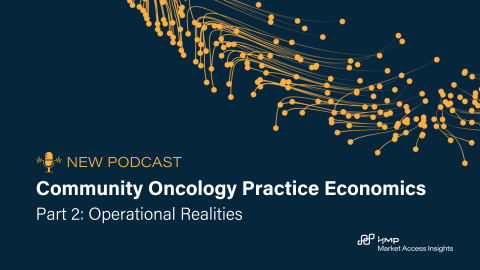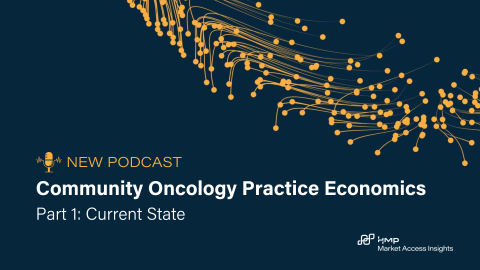

Podcast
Community Oncology Practice Economics - Podcast Part 2 of 3
November 14, 2024Authors
Topics
In part 2 of this 3-part podcast series, HMP Executive Vice President Lee Blansett and special guest John Hennessy—health system, provider and oncology strategist—explore the operational realities of oncology practice economics.

In the second episode of Oncology Practice Economics, John and Lee continue their conversation, focusing on the operational realities. If you missed Part 1, you can listen to it here.
Read full transcript:
Ashutosh Sheth: Welcome back to the HMP Market Access Insights Q3 2024 podcast on oncology practice economics with special guest, John Hennessy. Here in part 2, we pick up the conversation where Lee and John are talking about the operational realities of oncology practices.
Lee Blansett: Overall, my biggest concern going forward in the practice is that we've gone through this period of evolution and fine-tuning, it's continually going on. But if you look at the impact—this is 1 of our models on COVID—what happens when your referrals start dropping or your volume starts dropping? It doesn't take a big reduction in volume to severely injure a practice. You look at our estimate here, 10% decline in patient volume for IV therapy cuts the margin by almost 30% in the group.
John Hennessy: The biggest change that I've seen since I was involved in running a practice day-to-day and now is that we have more options in later-line therapy. To your point, when we would consider what if we lost 50% of our referring physician business, we saw that for about a year we were fine, but that's when things started to drop off. I think that can extend a little longer now because you can offer more treatments to your existing patients, but that doesn't reverse that eventual problem you're going to have—that every practice at some point relies on new patients as much as anything else. What's unique about medical oncology, compared to radiation oncology or surgical specialties, is that the impact of a reduction in new patients takes a little bit longer to flow through than in those other areas. So, you might find a little bit more urgency there. We're talking about urology later this week. Urology is another place where, because the disease process for prostate cancer tends to be slow, you do have a little more time, if the referral sources start drying up, to see the real economic impact on the practice.
Lee Blansett: We’ve certainly heard, particularly in some of the small practices, that the number of patients they have has clearly declined, but because patients are on treatments longer for each cycle, or for each round of therapy, the patients are staying with them longer. So they're getting 2 to 3 years with a colorectal cancer patient, due in large part to PD-1s, and then they're moving on to something else. Whereas before, they received 6 months of 5-fluorouracil plus leucovorin and maybe irinotecan, and then the patient would be moving on to the next therapy. They were gone in a year and a half or so.
John Hennessy: That’s part of the growth of the practice, but it’s also created stress on the practice. You need more nurses to provide that [treatment] administration. Despite the fact that we've really advanced what we can do with patients, there is still a lot of what we do that has a substantial side effect burden on the patient. Emesis, nausea, those things haven't gone away. We certainly don't see reactions in the infusion room, where people just have a terrible reaction and drop on you. That doesn't happen as often. But when you have patients who are on these therapies for a long time, in particular, I think of treat-to-progression therapies in chronic lymphocytic leukemia (CLL), where we have cumulative adverse events, you really do need to pay attention to those folks in a way you hadn’t before. Certainly, what we've seen since we both started in this is a huge growth in the use of advanced practice practitioners, nurse practitioners, and physician assistants to help the practice absorb that volume, do it in an economically sound fashion and in a staffing sound fashion, so that the primary oncologists are still around to see those new patients, and make sure you're open to those experiences. One of the challenges for practices transitioning into hospital settings, where their compensation model maybe doesn't emphasize new patients as much, is that some of those practices almost strangle themselves by having so much of a focus on the economics of follow-up patients. They're not leaving the spaces open to bring in new patients on a timely basis. If you're not thinking about it, you can wind up creating a problem you didn't intend to just because of the way you've organized your practice.
Lee Blansett: Right, so you're too busy taking care of the current patients, and when they leave, no one is there.
John Hennessy: We're having great successes and when I looked at my practice, the fastest-growing part of my practice was long-term survivors. As an oncologist, it's great to take care of long-term survivor patients. It's a great visit. The patient is doing well, it's a nice break in the day. You can see why you'd want to fill your calendar with that. But the practice needs to be filled with new patients. The referring physicians need that resource as well. It’s important to make sure that when you're running a practice, you find a way to take what's easy, that fast-thinking, and think a bit slower about how you’re going to make sure you’re making capacity available for your community.
Lee Blansett: So you can stay afloat.
Ashutosh Sheth: Thank you all for listening. This concludes part 2 of this 3-part podcast by HMP Market Access Insights on oncology practice economics. In Part 3, Lee and John will delve into emerging models of success for oncology practices.
The Latest
Podcast
Community Oncology Practice Economics - Podcast Part 2 of 3
In part 2 of this 3-part podcast series, HMP Executive Vice President Lee Blansett and special guest John Hennessy—health system, provider and oncology strategist—explore the operational realities of oncology practice economics.
Lee BlansettPodcast
Community Oncology Practice Economics - Podcast Part 1 of 3
In part 1 of this 3-part podcast series, HMP Executive Vice President Lee Blansett and special guest John Hennessy—health system, provider and oncology strategist—explore the current state of oncology practice economics.
Lee BlansettArticle
Navigating the 340B Maze Amid the Inflation Reduction Act
As the Inflation Reduction Act (IRA) introduces new Maximum Fair Pricing (MFP) rules, integrated delivery networks (IDNs) and manufacturers will face the complexities of navigating overlapping 340B discounts and MFPs.
Emma Bijesse





